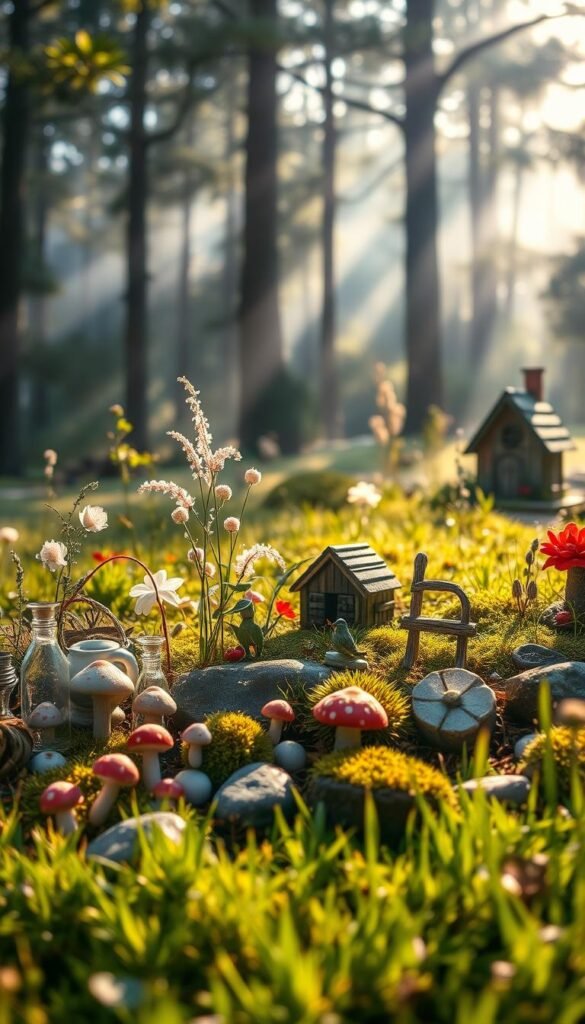Imagine crafting a tiny world where creativity blooms alongside miniature plants. These enchanting spaces blend nature with fantasy, offering endless opportunities to design whimsical landscapes in containers or outdoor nooks. Whether you’re new to gardening or a seasoned plant lover, building your first project requires just a few basics.
Start with a container – anything from an old teacup to a weathered planter works. Add soil suited for small plants, then choose hardy varieties like succulents or mosses that thrive in confined spaces. For inspiration, explore this step-by-step guide to combine natural elements with playful accents.
Don’t stress about perfection. The magic lies in mixing textures like smooth stones, weathered wood, and sparkling gravel. Tiny accessories – think miniature benches or rustic pathways – add personality without overwhelming your design. Best of all, you can expand your collection gradually as ideas evolve.
Focus on quality over quantity when selecting tools. A small shovel and pruning shears handle most tasks, while creative touches like seashells or repurposed jewelry make your creation unique. Remember: even simple arrangements become extraordinary when paired with imagination.
Introduction to the Enchanting World of Fairy Gardens
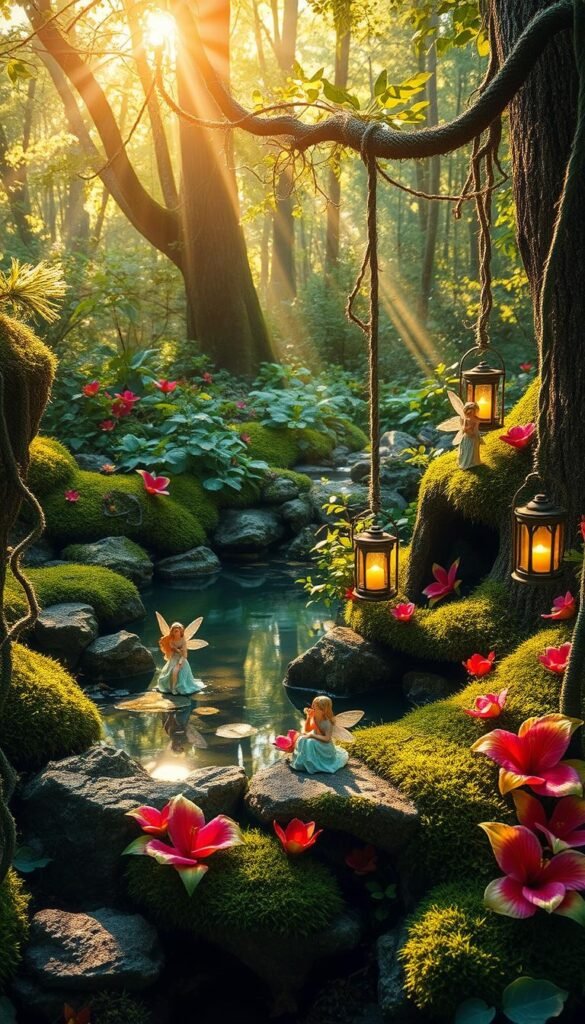
Uncover a century-old tradition where creativity flourishes in palm-sized ecosystems. These miniature landscapes first gained popularity during America’s 1920s miniatures trend, blending gardening with storytelling. Rooted in Celtic beliefs that fairies dwelled in sacred groves, these tiny habitats invite mythical energy into modern spaces.
What makes these creations special? They’re more than pretty decorations. Studies show arranging small natural elements helps kids develop fine motor skills and emotional awareness. Adults find stress relief through mindful design choices, like positioning pebble paths or mossy mounds.
| Traditional Gardening | Fairy Gardening | Key Benefits |
|---|---|---|
| Focuses on plant growth | Combines flora with fantasy | Boosts creativity |
| Requires large spaces | Thrives in containers | Saves space |
| Seasonal maintenance | Year-round indoor/outdoor | Flexible projects |
Start your journey with this step-by-step guide. Whether crafting a woodland scene in a clay pot or building a desert oasis with succulents, each garden becomes a living storybook. The real magic? Watching children’s eyes light up as they spot “fairy footprints” in the sand or arrange tiny mushroom stools.
No two designs are alike – that’s the beauty. Some prefer rustic bark bridges, while others add glittering crystal accents. Your tiny world can evolve weekly, making it perfect for restless creatives or families seeking shared hobbies.
Fairy Garden Supplies Essentials: Everything You Need to Get Started
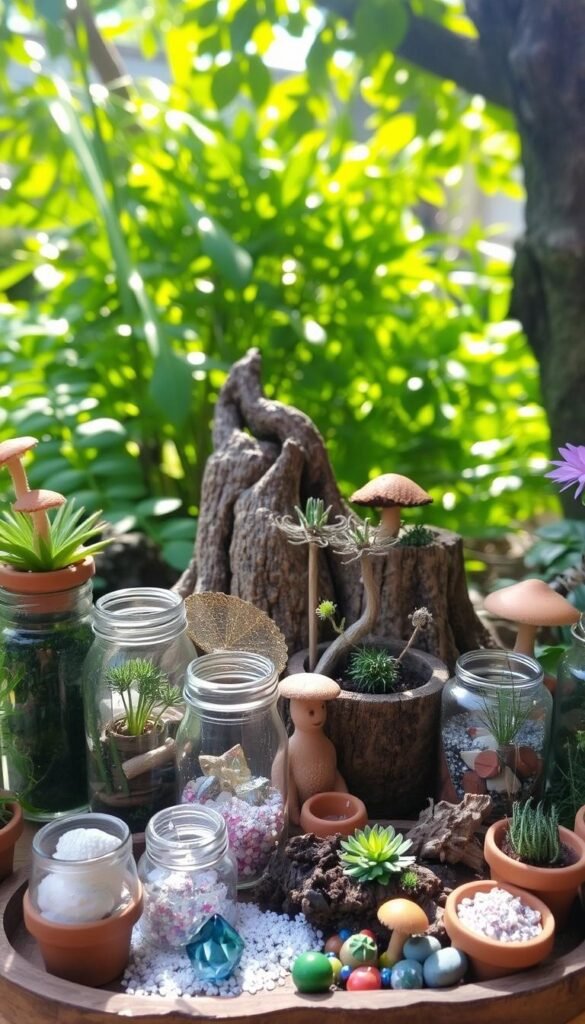
Creating a thriving miniature landscape requires seven key elements. Start with a container – clay pots, wooden boxes, or upcycled bowls work beautifully. Drainage holes prevent root rot, but you can drill them yourself if needed.
Next, choose fast-draining soil mixed with perlite or sand. This keeps delicate roots healthy, especially for drought-tolerant succulents like hens-and-chicks. Pair these with creeping thyme or moss for contrasting textures.
Natural materials shape your scene’s personality. Smooth river rocks become stepping stones, while coarse gravel mimics mountain terrain. A sprinkle of colored sand adds whimsy to “magic circles” or dry creek beds.
Miniature structures spark storytelling magic. A 2-inch resin cottage creates focal points, while tiny lanterns suggest hidden inhabitants. Mix scale-appropriate items – a 1:12 scale bench fits better than oversized decorations.
Essential tools simplify maintenance:
- Precision tweezers for placing pebbles
- Mini rake for soil texturing
- Mister bottle for gentle watering
Local nurseries often carry specialty plants, while craft stores stock themed accessories. For rare finds, Etsy sellers offer hand-painted miniatures that elevate designs from cute to extraordinary.
Selecting the Perfect Container for Your Miniature Wonderland
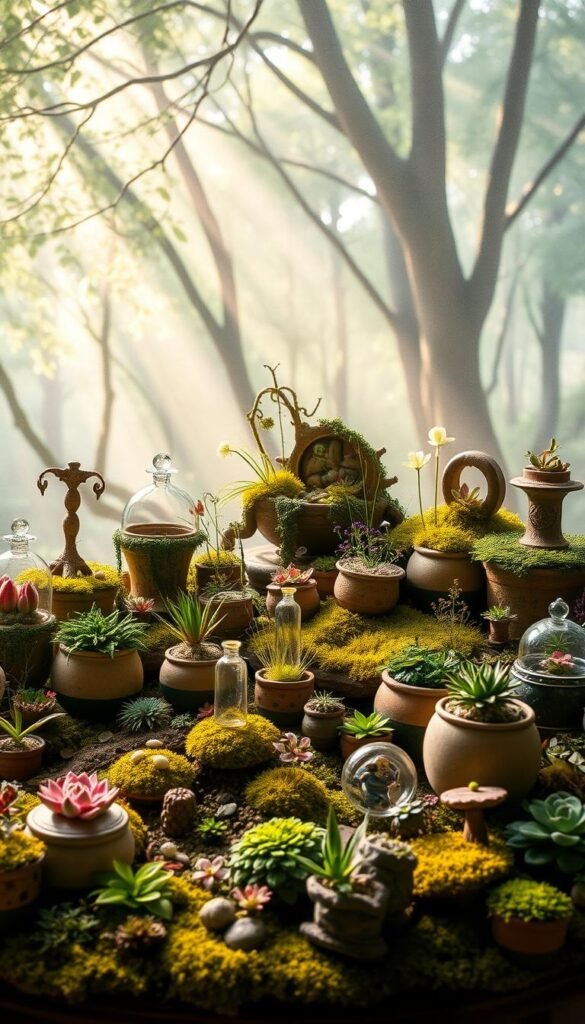
Your container acts as the canvas for miniature magic. Whether repurposing a chipped wheelbarrow or using a cedar planter, this choice shapes your tiny world’s personality. Terra-cotta pots remain popular for their breathability and timeless look, but don’t shy away from quirky options like overturned barrels or thrifted birdbaths.
Size matters more than you might think. Compact containers work for single-scene designs, like a mossy grove with one miniature bench. Larger spaces, such as raised beds or half-wine barrels, let you craft multi-zone landscapes with winding paths and hidden nooks.
Always prioritize drainage. If your chosen vessel lacks holes, grab a drill – even ceramic bowls can become plant-friendly homes. Lined baskets or wooden crates? Add a waterproof layer first to prevent rot.
Consider placement early. Lightweight options like plastic tabletop planters simplify rearranging, while stone troughs anchor outdoor displays. Match your design to your home’s aesthetic: rustic farmhouse? Try galvanized metal. Modern apartment? Glazed geometric pots add sleek contrast.
Remember: the best containers spark joy while giving plants room to thrive. Start simple, then expand as your tiny ecosystem grows.
Choosing the Right Soil and Dirt for Your Fairy Garden
The secret to a flourishing miniature ecosystem lies beneath the surface. Your soil acts as both anchor and buffet for tiny roots, determining whether plants thrive or barely survive. Quality mixes prevent waterlogging while delivering nutrients to sustain growth.
Soil Types for Succulents vs. Traditional Plants
Drought-tolerant varieties like sedums need gritty blends with perlite or coarse sand. These mimic their natural rocky habitats, letting roots breathe between waterings. For leafy greens or flowering plants, opt for organic potting soil – its moisture-retaining texture supports consistent growth in small spaces.
Enhancing Drainage and Nutrients
Mix in mushroom compost or worm castings to boost fertility without compacting the ground. A quality container soil mix forms the ideal base, draining faster than regular dirt. Avoid using backyard soil – it often carries pests and turns concrete-hard in pots.
Test your blend by squeezing a handful. It should crumble apart easily, not stay clumped. Add gravel at the container’s base if water pools on the surface. Remember: happy roots mean vibrant, long-lasting greenery that enchants for seasons.
Picking the Ideal Plants to Bring Your Fairy Garden to Life
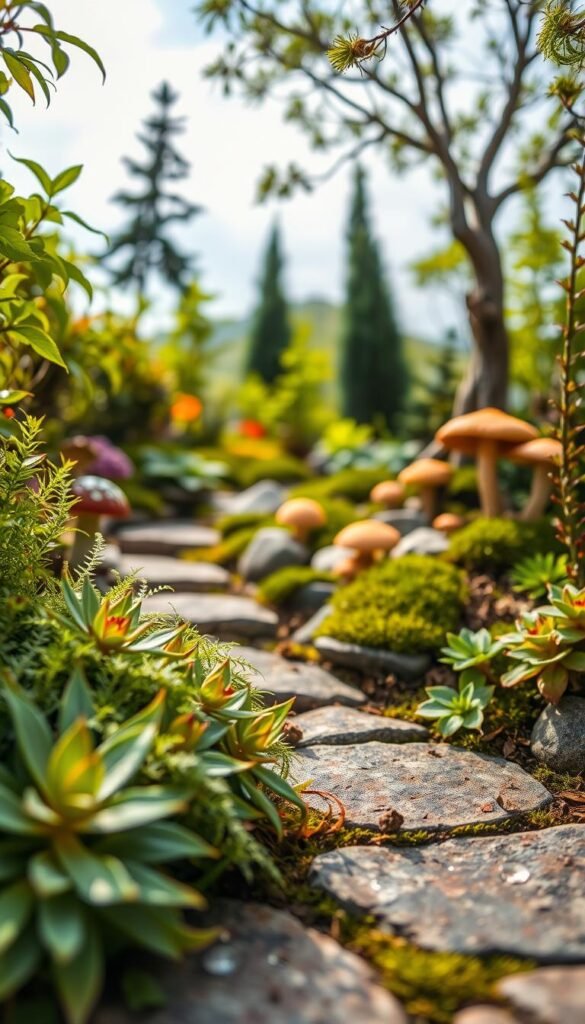
The heart of your tiny landscape beats in its greenery. Selecting the right plants balances beauty with practicality, ensuring your creation thrives in your specific climate and light conditions. Let’s explore options that turn your vision into a living masterpiece.
Sun-Loving Options and Shade-Friendly Varieties
Bright, sunny spots demand resilient species. Try these sun-worshippers:
- Creeping thyme: Forms fragrant mats perfect for pathways
- Sedums: Offer succulent texture in gold or burgundy
- Dwarf coreopsis: Adds cheerful yellow flowers
Shaded areas unlock woodland magic. Consider:
- Hosta varieties: Ruffled leaves create depth
- Ferns: Deliver feathery contrast to smooth stones
- Coral bells: Provide pops of purple or lime
Your local climate dictates success. Arid regions thrive with hens-and-chicks or ice plants, while humid zones support miniature roses. For practical container gardening tips, focus on drainage and scale.
Mix heights and textures for visual drama. Use upright herbs like rosemary as “trees” beside trailing Irish moss. Remember: small plants need regular pruning to maintain their fairy-sized proportions. Your living artwork evolves with each season – embrace the growth!
Essential Tools to Craft Your Magical Garden Setup
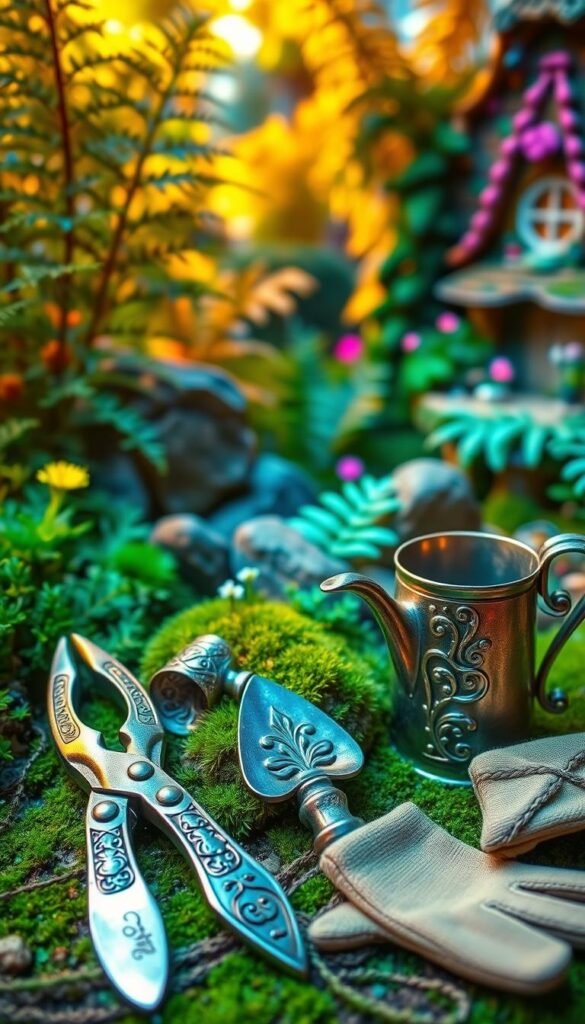
The right instruments transform miniature landscapes from messy experiments into polished scenes. Precision becomes your ally when working with delicate plants and tiny decorations. Let’s explore how specialized gear streamlines the creative process while protecting your living artwork.
Shovels, Pruning Shears, and Other Must-Haves
A hand shovel handles heavy lifting – digging planting holes and redistributing soil. Its mini counterpart reaches tight corners without disrupting nearby roots. For shaping plants to storybook proportions, sharp pruning shears maintain scale while encouraging healthy growth.
Long tweezers position pebbles along winding paths or adjust fragile mushrooms. Terrarium tongs rescue fallen acorn caps from beneath leafy canopies. Keep materials organized with labeled containers – separate compartments for sand, gravel, and moss prevent creative chaos.
Don’t underestimate a soft paintbrush. It sweeps debris from miniature cottages and polishes river stones to a natural shine. A tiny rake textures soil for woodland trails or Zen garden patterns, adding professional flair in seconds.
These tools save time during setup and maintenance. Compact designs fit in apron pockets, letting you tweak details whenever inspiration strikes. With the right gear, every gardening step becomes a joyful way to nurture your tiny ecosystem.
Incorporating Stones, Rocks, and Natural Pathways
Transform your miniature landscape into a storybook scene using nature’s building blocks. Rocks and stones anchor your design while adding earthy charm. Start with flat river rocks to craft winding paths that guide eyes through hidden nooks. Stack larger stones vertically with clay-rich soil as natural “glue” for terraced walls or rustic benches.
Mix textures for visual drama. Smooth pebbles create serene creek beds, while jagged granite adds rugged contrast. For magical accents, tuck polished crystals between moss patches or arrange sea glass as shimmering water features. Even broken tile pieces become mosaic stepping stones when arranged creatively.
Balance function with fantasy. Use gravel to define separate areas in your garden, like a tiny fire pit zone or flowerbed borders. Larger boulders make perfect backdrops for miniature structures, giving scenes depth and scale. Remember: rainwater naturally collects around stones, helping nearby plants thrive without extra watering.
Let your personality shine through unconventional choices. Marbles become “fairy orbs,” while colored glass chips mimic enchanted pools. These elements evolve with your design – rearrange them seasonally or as new ideas strike. The best part? Every rock tells a story in your ever-changing tiny world.

